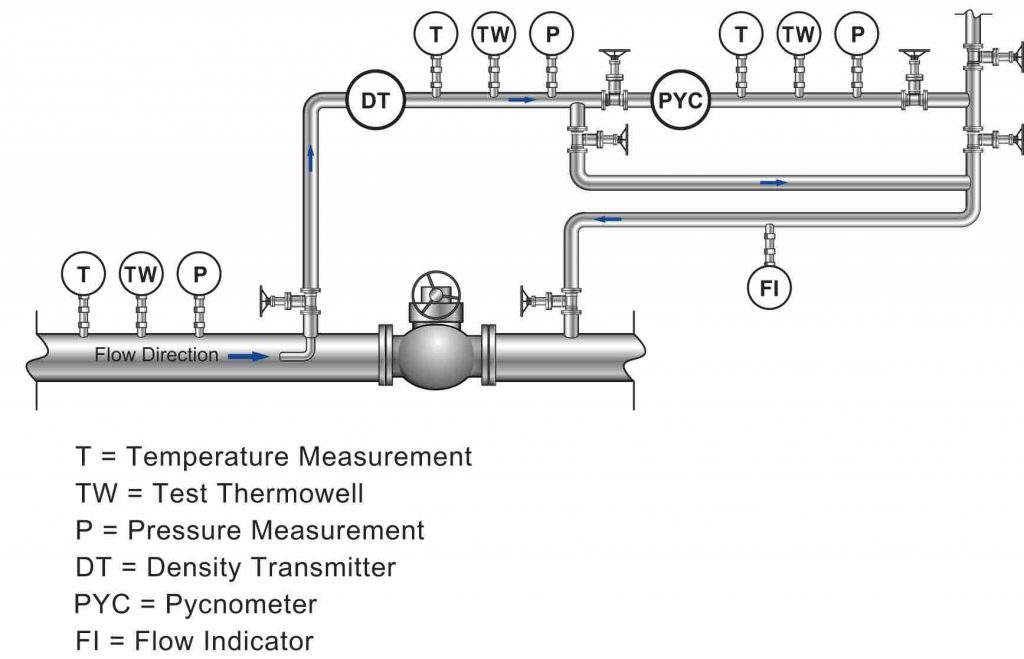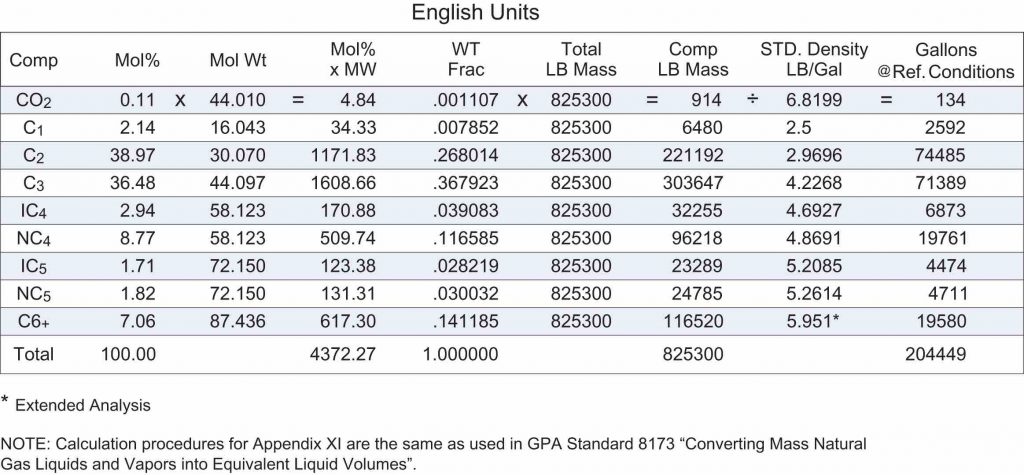July 2016, Vol. 243, No. 7
Features
NGL Measurement: Direct and Inferred Mass

Natural gas liquid (NGL) streams consist of mixtures of hydrocarbons including ethane, propane, butane, pentane and natural gasoline. NGL is sometimes referred to as y-grade. The American Petroleum Institute (API) Manual of Petroleum Measurement Standards (MPMS) Chapter 14, Section 7 provides guidance on the mass measurement of NGL. Mass measurement techniques are applied to NGL to avoid measurement errors that are caused by the solution mixing within the NGL stream.
Mass measurement can be achieved by direct measurement with a Coriolis flow meter or inferred by multiplying a volumetric flow rate times flowing density. There are important advantages to be aware of with direct mass measurement for NGL streams.
Individual components in an NGL stream are bought and sold on a volumetric basis. There is a simple process to convert the measured mass of the combined NGL stream into the standard volumes of each individual component for this purpose.
Solution Mixing
NGL solution mixing results when different-sized molecules flow together in an NGL stream. Smaller molecules fit within voids in the structure of larger molecules. An analogy can be made to mixing sand and marbles. Mixing one barrel of sand and one barrel of marbles yields less than two barrels of mixture (Figure 1). This happens because the sand fills the spaces around the marbles that were empty when the marbles and sand were separate.
Simultaneously varying the NGL stream composition, temperature and pressure makes it impossible to predict the resulting volume of the hydrocarbon mixture. It is not possible to apply temperature and pressure volume correction factors from API MPMS Chapter 11 on NGL streams for this reason. An NGL stream’s measured mass is the only possible accurate measurement of true quantity because mass is independent of composition, temperature, pressure and solution mixing.

Figure 1
Mass/Volume/Density
Mass, volume and density are related:
Mass = volume x density
Volume = mass/density
Density = mass/volume
Mass can be measured directly using a Coriolis flow meter or inferred by measuring volume and density at flowing conditions.
Dividing mass by density at flowing conditions yields indicated volume. Volume at standard conditions can be determined by dividing mass by the density at standard conditions.
Direct Measurement
Direct mass measurement is achieved by using a Coriolis flow meter and programming the transmitter to output pulses per unit mass (pulses per pound). Coriolis flow meter installations should follow the guidance provided in API MPMS Chapter 5, Section 6.
API MPMS Chapter 14, Section 7 provides an equation for direct mass measurement:
Qm = ImmxMFm
Where:
Qm = mass flow
Imm = indicated Coriolis meter mass
MFm = meter factor for Coriolis meter mass
The direct mass equation includes only two terms. Direct mass meters require that a mass meter factor be derived by mass proving. This requires the addition of an online density measurement at prover conditions (prover volume x density = mass) if a volume prover is used.
Inferred Measurement
Inferred mass measurement is achieved by using a volumetric flow meter in conjunction with an online density measurement at flowing conditions. Volumetric flow meters should be installed with guidance from an appropriate section of the API MPMS Chapter 5, depending on the meter technology selected (such as API MPMS Chapter 5, Section 3 for turbines).
API MPMS Chapter 14, Section 7 provides an equation for inferred mass measurement:
Qm = IV x MFv x ρf x DMF
Where:
QM = mass flow
IV = indicated meter volume at operating conditions
MFv = volumetric meter factor
ρf = observed density at operating conditions
DMF = density meter factor
The inferred mass measurement calculation has two additional terms for a flowing density and a density meter factor. Inferred mass density measurement guidance is provided by API MPMS Chapter 14, Section 6 (this document will be superseded by API MPMS Chapter 9, Section 4 in the near future). Because of their size and limited flow rate capacity, density meters (Figure 2) are generally installed in a bypass loop from the main flow line.
Maintaining conditions (such as pressure, temperature and composition) of the sample flowing through the density bypass loop such that the sample density is representative of the product flowing through the volumetric (duty) flow meter can be a Figure 2challenge. Differences in process conditions between the duty flow meter and the density meter will result in additional mass measurement errors that do not exist in a direct mass measurement system.
Figure 2
Density Measurement
Density measurement is required on a volume prover for direct mass proving. Density meters are often placed on a piston prover’s outlet across a valve or other restriction to create flow through the density loop. Inferred mass measurement systems have a continuous density measurement loop.
Density loops should include pressure (P) and temperature (T) measurements at the density meter (DT) and pycnometer (PYC) outlets in order to ensure equal process conditions when a pycnometer sample is pulled. Regardless of where a density loop is located, a density meter factor is required. API MPMS Chapter 14, Section 6 provides guidance on calibrating density meters against a pycnometer.
A flow-weighted, proportional fluid sample is collected during the measurement interval. The sample pressure must be maintained above the fluid vapor pressure in order to prevent liquid-vapor separation from occurring in the sample container or the composition of the sample will no longer be representative of the flow stream. The fluid samples are then analyzed by gas chromatography in order to determine the weight fraction of each component in the fluid stream at the time the total mass measurement was made.
Online Analysis
Many operating companies have adopted online fluid analysis using gas chromatographs installed near the mass measurement system. A gas chromatograph (GC) measures the flowing fluid composition and provides compositional data to a flow computer. Online analysis is used to eliminate a need for handling and processing manual samples. Gas Processors Association Standards GPA 2261 and GPA 2177 provide some guidance on GC NGL measurement applications.
The API MPMS Chapter 14, Section 4 provides guidance for converting NGL mass quantities to equivalent volumes. NGL samples obtained during the measurement period are analyzed to determine the weight fraction of each stream component or measured in real time via an online gas chromatograph (GC).
The weight fraction of each component is multiplied by the total NGL mass which yields the individual mass quantities of each component. Dividing each component mass by the density at standard conditions that is published for each pure component provides the standard volume at reference conditions of each NGL stream component. Table 1 shows a mass-to-volume conversion of an NGL stream.
Table 1
Conclusion
Mass measurement techniques are used extremely effectively to measure NGL. Solution mixing makes predicting NGL volumes impossible under varying composition, pressure and temperature. Several sections of the API MPMS provide guidance for the mass measurement of NGL.
NGL mass can be measured directly with Coriolis flow meters. Inferred mass can be determined by multiplying a volumetric flow meter volume times density. Direct mass measurement systems have the distinct advantage of not needing online continuous line density measurement during the measurement interval.
NGL mass is converted to the individual component volumes by determining the mass of each component from the GC analysis and dividing by the density of each pure fluid at standard reference conditions.







Comments